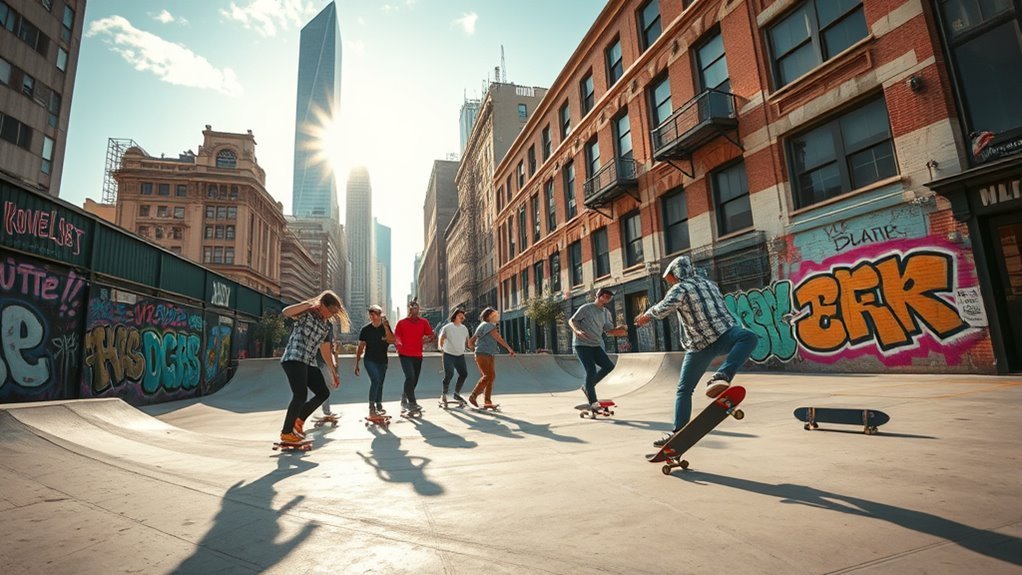Imagine walking through a city where every curb, staircase, and ledge holds a story of transformation. You’re witnessing a canvas where skateboarding reshaped urban culture. From its humble beginnings in the 1950s, skateboarding turned everyday streets into creative playgrounds. As you explore this evolution, consider how these dynamic spaces fostered community and inclusivity, redefining city landscapes. What’s next in this cultural journey?
Key Takeaways
- Skateboarding originated in California in the late 1940s, as surfers sought to replicate the experience of riding waves on land.
- The 1970s witnessed a resurgence of skateboarding, marked by innovations such as polyurethane wheels and the introduction of the first artificial skate park.
- Skateboarding transformed urban spaces into playgrounds, utilizing public architecture, such as curbs and stairs, for creative expression.
- The 1980s to present day marked skateboarding’s cultural integration, influencing urban design and fostering community through skate parks.
- Skateboarding’s acceptance in urban settings culminated in its debut at the 2020 Olympics, highlighting its global impact.
Origins and Early Influences
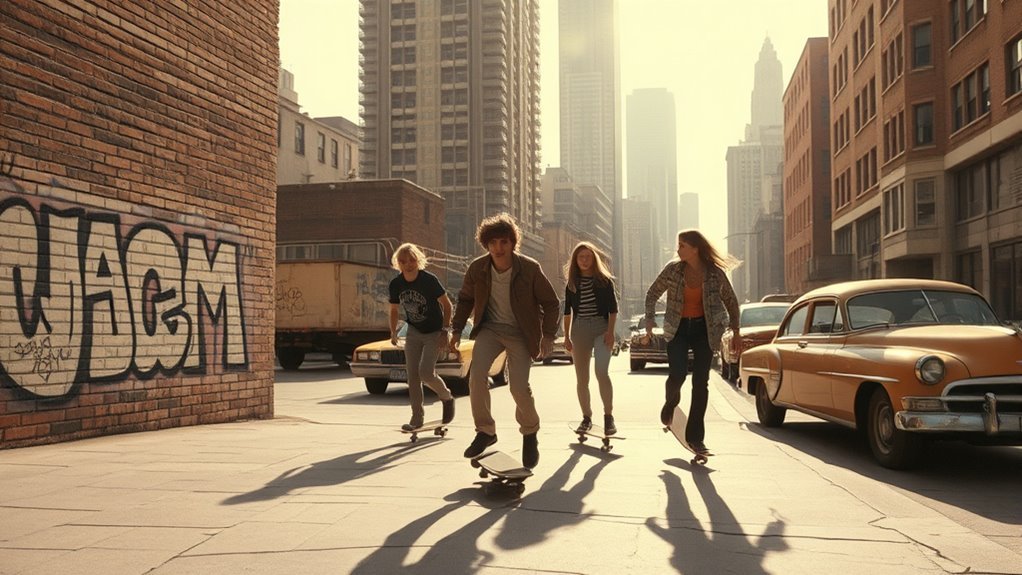
Although skateboarding as we perceive it today has evolved considerably, its origins trace back to the late 1940s and early 1950s in California.
You can imagine surfers wanting to recreate the feeling of riding waves, leading to the birth of “asphalt surfing.” This early version of skateboarding was crafted by Bill Richard, who attached roller skate wheels to wooden boxes.
Skate culture began to take shape, and by the 1960s, it had flourished. The release of the first official skateboard by Roller Derby in 1959 was a game-changer, improving handling and sparking interest.
As innovations like Larry Stevenson’s kicktail emerged, skateboarding transformed, paving the way for professional skateboarders and competitions and cementing its place in sports history.
The 1950s: Surfing to Asphalt Surfing
When surfers in California wanted to bring the thrill of riding waves to land, they inadvertently set the stage for a new sport: skateboarding. This innovation, known as “asphalt surfing,” began in the late 1940s and early 1950s.
You’d find skateboarders crafting their boards by attaching roller skate wheels to wooden boxes, transforming sidewalks into their version of the ocean. Initially, California and Hawaii were the main hubs for this burgeoning activity.
By the late 1950s, skateboarding’s popularity surged across the United States, fueled by a booming economy and inventive tricks. The release of Roller Derby’s official skateboard in 1959, offering improved handling, marked a pivotal moment.
Skateboarding wasn’t just a pastime; it became a thrilling new way to ride.
The 1960s: Commercialization and Competition
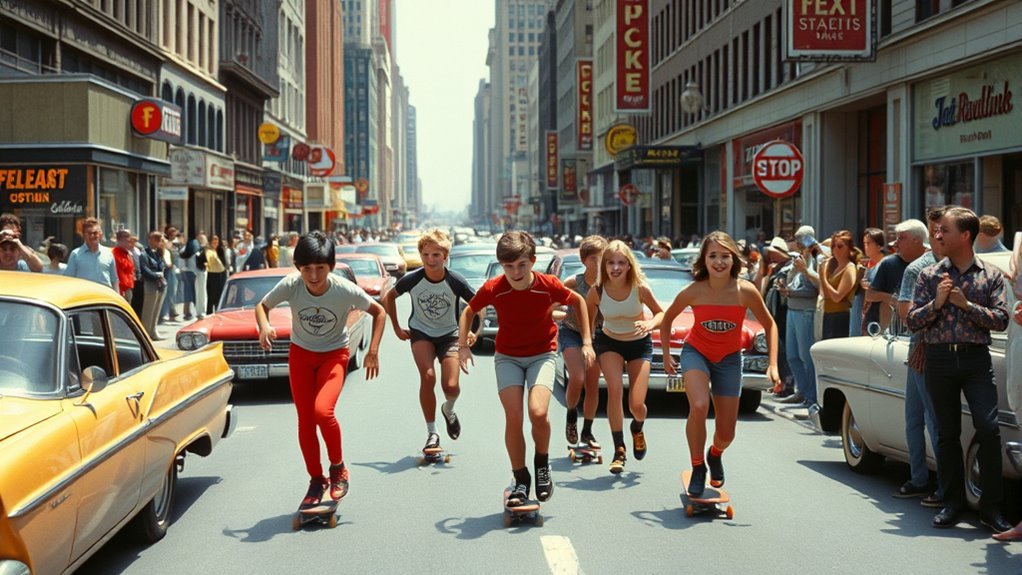
In the 1960s, skateboarding experienced a boom as it transformed into a commercial powerhouse, with shops like Val Surf in Hollywood selling the first self-produced boards.
This era wasn’t just about sales; it also marked the start of competitive skateboarding, highlighted by the inaugural contest at Hermosa Beach in 1963.
As the excitement grew, you saw skateboarding evolve into a popular sport with professional riders making headlines.
Skateboard Sales Boom
The 1960s marked a pivotal era for skateboarding, characterized by a surge in sales and competitive spirit.
Between 1963 and 1965, skateboard sales skyrocketed, with Makaha reporting $4 million in sales, underscoring the sport’s growing popularity.
Val-Surf in Hollywood played an essential role by selling the first self-produced skateboards in 1962, making them widely accessible.
The emergence of skateboarding competitions, like the first contest in Hermosa Beach, fueled public interest.
The introduction of industrially produced boards by Patterson Forbes in 1962 further broadened access.
Additionally, televised skateboard championships in 1965 captivated audiences, enhancing their allure.
As skate parks began sprouting, the sport’s popularity continued to skyrocket, cementing its place in the city’s culture and hearts.
First Skate Contests
As skateboarding began to capture the public’s imagination in the 1960s, Hermosa Beach, California, hosted the first official skateboarding contest in 1963. This event showcased groundbreaking maneuvers and tricks, marking a pivotal moment in the sport’s commercialization. Val-Surf in Hollywood had already started selling the first self-produced skateboards in 1962, fueling interest in skateboarding contests. These competitions began attracting media attention, elevating skateboarding’s status as a competitive sport. The release of The Quarterly Skateboarder, the first skateboarding magazine, in 1964 played a crucial role in promoting this growing culture.
| Year | Milestone |
|---|---|
| 1962 | First self-produced skateboards |
| 1963 | First skateboarding contest |
| 1964 | First skateboarding magazine |
| 1960s | Rise in skateboarding contests |
The 1960s laid the foundation for the sport’s future.
The 1970s: Innovations and Resurgence
During the 1970s, skateboarding experienced a resurgence fueled by groundbreaking innovations and a new wave of enthusiasm.
Skateboarding has become more accessible and exciting thanks to Frank Nasworthy’s introduction of polyurethane wheels in 1972, which offered smoother rides and improved traction. The first artificial skate park opened in 1976, featuring thrilling vertical ramps.
Meanwhile, the Z-Boys brought a surf-inspired style, enchanting audiences with their daring moves. A pivotal moment occurred in 1975 with the Del Mar National Championships, which revived competitive skateboarding.
Alan Gelfand’s invention of the Ollie in 1978 was transformative, laying the foundation for street skating.
You can see how:
- Innovation fueled progress.
- New parks created possibilities.
- Z-Boys redefined style.
- Competitions spurred growth.
The 1980s: Street Style and Media Revolution
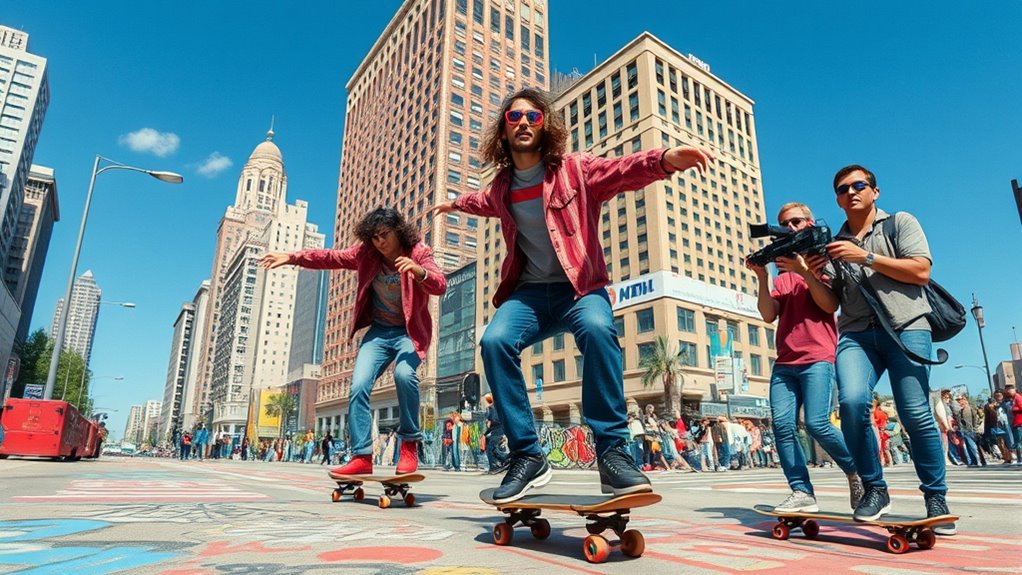
While the 1980s brought a major transformation to skateboarding, it was Rodney Mullen’s popularization of the Ollie that truly revolutionized the sport. The Ollie allowed skaters to perform new tricks, leading to the rise of street skating.
This era saw a significant shift as skaters took to the urban environment, using every surface as a potential playground.
Thrasher Magazine, launched in 1981, became a cultural cornerstone, merging skate culture with the rebellious spirit of punk rock. Its influence expanded the visibility and appeal of skateboarding, making it more than just a sport—it became a lifestyle.
The rise of skate videos on VHS further fueled the movement, showcasing innovative styles and tricks and making stars out of daring skaters.
The 1990s: Decline and Revival
Though the 1990s started with a downturn for skateboarding, the decade marked a turning point that would eventually lead to its revival.
Initially, skateboarding faced a decline as alternative sports gained popularity, but digitalization kept it visible.
By mid-decade, a resurgence was evident, fueled by events like the X-Games. New brands such as Chocolate and Flip Skateboards emerged, revolutionizing skateboard design and quality.
By the late 1990s, professional skateboarding had transformed into a lucrative industry.
Here’s how the decade unfolded:
- Decline: The Early 1990s saw a decrease in participation and sales.
- Visibility: Digital content spread skateboarding’s reach.
- Resurgence: X-Games brought excitement back.
- Professional Growth: Skateboarding has evolved into a competitive and profitable sport.
The 1990s truly set the stage for skateboarding’s future.
2000s to Present: Mainstream Acceptance and Olympic Inclusion
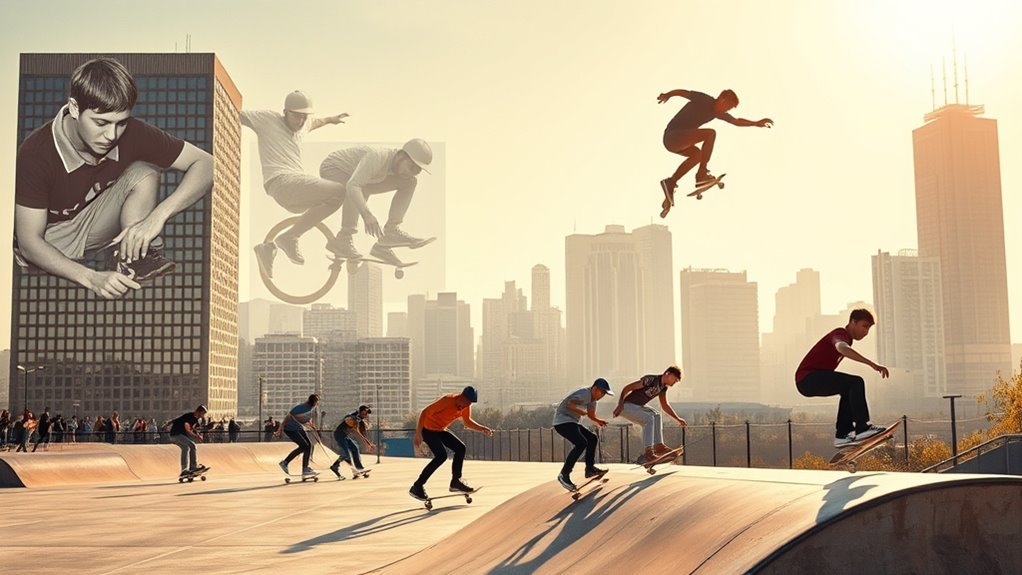
Since the turn of the millennium, skateboarding has evolved from a niche subculture to a globally recognized sport. The popularity of skateboarding began to surge with the rise of digital platforms and social media, making it a part of youth culture worldwide. By 2021, there were about 50 million riders globally. The complete history of skateboarding saw a significant milestone with its debut in the 2020 Olympic Games, showcasing diverse styles of skateboarding for both men and women.
Here’s a brief look at skateboarding’s journey:
| Year | Milestone |
|---|---|
| Early 2000s | Rise of digital influence |
| 2010 | Mainstream competitions like the X-Games |
| 2020 | Olympic inclusion |
| 2021 | 50 million global riders |
| Present | $4.8 billion market value |
This acceptance and professionalization mark a new era for the sport.
Cultural Impact and Urban Transformation
When you think about skateboarding, you’re not just picturing a sport; you’re witnessing a cultural force that reshapes city landscapes.
From repurposing urban spaces into skate-friendly environments to influencing architectural designs, skateboarding challenges how we interact with public spaces.
Its impact isn’t just physical—it fosters a sense of community and expression that echoes through city streets worldwide.
Skateboarding’s Urban Influence
As skateboarding emerged in urban settings, it didn’t just bring a sport to the city streets; it transformed them into dynamic playgrounds for creativity and expression.
You’d find that skateboarding reshaped urban culture by turning everyday public spaces into skateable features.
Here’s how it changed the urban landscape:
- Redefining Architecture: Skateboarders saw curbs and staircases not as obstacles, but as opportunities to showcase skill.
- Cultural Influence: Skate videos and magazines brought skateboarding’s raw energy to the masses, inspiring countless city dwellers.
- Community Hubs: Skate parks emerged, fostering interaction and bridging diverse backgrounds.
- Global Recognition: With skateboarding’s inclusion in the Olympics, its urban roots have gained worldwide appreciation. In your city, skateboarding isn’t just a sport—it’s a cultural revolution.
Cultural Expression Through Skateboarding
Skateboarding’s influence doesn’t stop at reshaping urban landscapes; it also serves as a powerful form of cultural expression. Emerging in the 1960s, skateboarding blended surf culture with urban environments, creating a vibrant subculture that challenged city norms.
The urethane wheels of the 1970s revolutionized skating, enabling tricks on urban architecture and transforming these spaces into canvases for creativity. Teams like the Z-Boys drew inspiration from their surroundings, celebrating individuality in public spaces.
Skateboarding media, through magazines and videos, fostered a sense of community and identity, shifting public perceptions of urban areas as skateboarding’s popularity soared—cities adapted by repurposing existing infrastructures and building new skateparks.
This dynamic relationship highlights how skate culture continues to reshape and influence urban transformation.
City Spaces Reimagined
While cities have traditionally designed spaces with a focus on functionality and order, skateboarding has redefined how urban landscapes can be experienced and utilized. By transforming urban environments, skateboarders repurpose public spaces, such as curbs, stairs, and plazas, into dynamic playgrounds. This shift has led to a cultural renaissance, fostering creativity and a sense of community.
The rise of skate parks in the 1970s, starting with California’s first artificial park, showcases how cities now embrace skateboarding as a legitimate recreational activity.
Consider how skateboarding impacts:
- Urban Design: Influencing architects to incorporate skateable elements.
- Public Spaces: Advocating for inclusivity and adaptability.
- Youth Culture: Cities investing in dedicated facilities.
- Community Identity: Encouraging participation across diverse groups.
Skateboarding’s impact reshapes our urban experiences.
Conclusion
You’ve witnessed how skateboarding has evolved from a street pastime to a monumental cultural force. From the early days of sidewalk surfing to its Olympic debut, skateboarding has reshaped urban landscapes and united diverse communities. It’s not just a sport; it’s a lifestyle that celebrates creativity and freedom. By embracing skateboarding, cities have transformed public spaces into vibrant hubs of activity, proving that what once seemed rebellious has become a celebrated art form and a unifying force.
FAQs
1. Where was Skateboarding invented in the City?
You might think skateboarding was invented in an urban setting, but it started in California. Surfers wanted to practice on land, so they created skateboards. Skateboarding later captured the energy of city life, evolving into an urban sport.
2. When Did Street Skateboarding Start?
Street skateboarding kicked off in the late 1970s. You’d see its roots with the Ollie, invented in 1978. This era marked a shift toward urban environments, steering people away from skate parks and ramps.
3. What Is the Historical Background of Skateboarding?
You’d find skateboarding’s roots in the late 1940s in California, where it was known as “sidewalk surfing.” Roller Derby released the first skateboard in 1959. Innovations such as polyurethane wheels and the kicktail have transformed the sport, leading to today’s diverse skateboarding culture.
4. Which Country Banned Skateboarding From 1978 to 1989?
You’re curious about which country banned skateboarding from 1978 to 1989. It was Germany. They enforced the ban due to safety concerns. However, skaters didn’t stop; they just went underground until the ban lifted.
